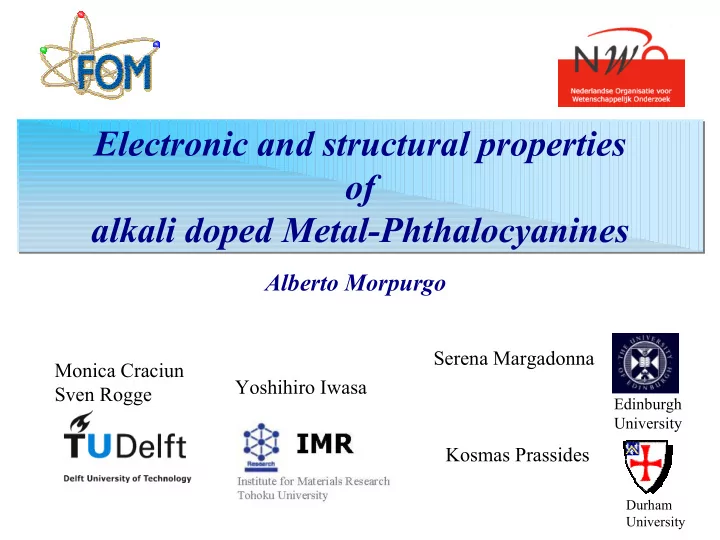

Electronic and structural properties Electronic and structural properties of of alkali doped Metal-Phthalocyanines alkali doped Metal-Phthalocyanines Alberto Morpurgo Serena Margadonna Monica Craciun Yoshihiro Iwasa Sven Rogge Edinburgh University Kosmas Prassides Durham University
Alkali intercalated C 60 Alkali intercalated C 60 K 6 C 60 insulator K 6 C 60 K 1 C 60 K 4 C 60 K 3 C 60 K 4 C 60 Mott-Hubard insulator K 1 C 60 K 3 C 60 metal metal Rich variety of electronic phenomena by tuning Superconducting transition the carrier density
The Metal-phthalocyanines (MPc’s) The Metal-phthalocyanines (MPc’s) - a class of over 70 MPc - isostructural MPc: Cu, Fe, Ni, Co, Mn,… - metal determines: Molecular spin Orbital generacy Shape/Location of Magnetism in doped MPc’s? orbitals - Exchange energy large Exchange via free carriers
Systematics of molecular orbitals: direct observation X.Lu, K.W.Hipps, X.D.Wang, U.Mazur J. Am. Chem. Soc. 118, 7197 (1996) The lowest The lowest CoPc CuPc energy molecular energy molecular orbital centered orbital centered on the metal ion on the Pc ring X.Lu, K.W.Hipps, J. Phys. Chem B NiPc FePc 11, 5391 (1997)
Magnetic properties of MPc Canted ferromagnet with T C = 8.6 K Canted soft ferromagnet with T C = 10 K MnPc FePc Awaga, Maruyama, Phys.Rev.B 44, 2589, 1991 Evangelisti et al., Pys.Rev.B 66, 144410 (2002) Undoped Crystals: Insulating ( α -form)
Electrical properties of MPc CuPc : p-type conductivity F-CuPc: n-type conductivity -1.75 X 10 -5 Drain-source current ( µ A) -1.40 X 10 -5 -100 V -1.05 X 10 -5 -80 V Drain current (A) -7.00 X 10 -6 -60 V -3.50 X 10 -6 -40 V -20 V 0 V 0.00 0 -20 -40 -60 -80 -100 Drain voltage (V) Drain-source voltage (V) Bao et al. , Apl.Phys. Lett. 69 (20), 3066, 1996 Bao et al. , J.Am.Chem.Soc. 120, 207-208 , 1998
Past work on MPc doping Only hole doping (e.g., Iodine doping) - carriers occupy same orbital in different MPc’s - range of accessible carrier density is limited Here: electron doped Metal Phthalocyanines
Outline Outline Alkali-doped MPc’s thin films � Insulator-Metal-Insulator transition as a function of electron density in six different MPc’s - Transport - STM � Comparison of different MPc’s & correlation with molecular orbitals properties Alkali-doped MPc’s bulk (powder) � Different structural phases - Intercalation � Independent evidence for charge transfer - Raman
Preparation of alkali doped MPc thin films Preparation of alkali doped MPc thin films UHV (10 -11 mbar) Film evaporation Transport measurements Alkali doping MPc I I Knudsen cell I doping Scanning probe source LHe characterization I
Doping dependence of the conductivity Doping dependence of the conductivity MPc Alkali E E DOS(E) DOS(E)
Insulator-metal-insulator transition Insulator-metal-insulator transition metal insulator insulator
Effect of Disorder CuPc on glass MPc reversibility of doping Ti / Au Glass conductivity induced by doping insulating behavior
Single Crystalline Grains α -form of CuPc STM image => crystal structure
Scanning Tunneling Spectroscopy Scanning Tunneling Spectroscopy local density of states I V * Undoped & overdoped: gap in STS * Optimally doped: finite density of states at E F
Differences in the behavior of MPc’s Differences in the behavior of MPc’s M.S. Liao, S. Scheiner, J.Chem Phys. 114 , 9780 (2001) ligand metal CuPc, NiPc, ZnPc: only 2e g is filled CoPc and FePc: 1e g and 2e g are filled
Systematics of molecular orbitals: direct observation X.Lu, K.W.Hipps, X.D.Wang, U.Mazur J. Am. Chem. Soc. 118, 7197 (1996) The lowest The lowest CoPc CuPc energy molecular energy molecular orbital centered orbital centered on the metal ion on the Pc ring X.Lu, K.W.Hipps, J. Phys. Chem B NiPc FePc 11, 5391 (1997)
Preparation of Potassium doped CuPc crystals Preparation of Potassium doped CuPc crystals Vapor phase reaction Solid state reaction Ar filled glove box: O 2 < 1ppm
The solid state reaction The solid state reaction
The vapor phase reaction The vapor phase reaction Powder X-ray diffraction phase2 phase1 a=16.9358(15) Å a=16.2433(10) Å b=5.9293(4) Å b=6.1300(5) Å c=13.4812(9) Å c=14.4482(2) Å β =113.457(2) o β =115.308(2) o 2.7 K per CuPc
Raman spectroscopy Raman spectroscopy elasting scattering E i E i – E r = Raman shift incident inelastic scattering E r light E i Information about molecular vibrations and rotations Vapor phase reaction Vapor phase reaction pristine phase1 Intensity phase2 Raman shift Solid state reaction Solid state reaction pristine Intensity phase 3 Raman shift Shift of Raman peaks upon doping Charge transfer from K to CuPc
Conclusions Conclusions � Insulator-Metal-Insulator transition as a function of electron density � Electronic transport directly related to molecular orbitals in MPc molecules � Formation of different structural phases upon doping � Independent evidence for charge transfer between alkali and MPc’s Alkali-doped MPc’s ideal model system for the study of the electronic properties of molecular solids
Recommend
More recommend